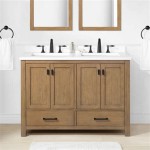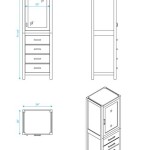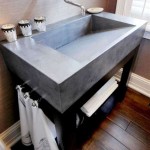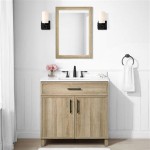Dresser to Bathroom Vanity Ideas: Repurposing Furniture for Style and Function
Repurposing furniture is a popular trend in home décor, driven by a desire for unique design, sustainability, and cost-effectiveness. Transforming a dresser into a bathroom vanity offers a way to inject personality into a bathroom while utilizing existing or vintage pieces. This article will explore the process of converting a dresser into a functional and stylish bathroom vanity, outlining the key considerations, steps involved, and design ideas to inspire your own project.
The allure of a dresser-turned-vanity lies in its distinct character. Unlike mass-produced vanities, a repurposed dresser brings a sense of history and individuality. The existing drawers and cabinet spaces provide ample storage, often exceeding the capacity of standard vanities. Furthermore, repurposing reduces waste by giving a new life to a piece of furniture that might otherwise end up in a landfill.
Before embarking on this project, careful planning is essential. Assess the existing bathroom space, the size and style of the dresser, and the plumbing considerations. A clear vision of the final product will streamline the process and ensure a successful transformation.
Key Point 1: Planning and Preparation
The initial planning phase is crucial for a successful dresser-to-vanity conversion. This involves assessing the current bathroom layout, evaluating the dresser's suitability, and considering plumbing requirements.
Firstly, measure the available space in the bathroom. Note the width, depth, and height restrictions, ensuring the chosen dresser fits comfortably without obstructing movement. Consider the placement of existing plumbing lines for the sink and drain. If relocating plumbing is necessary, it's generally advisable to consult with a qualified plumber.
Secondly, select a dresser that complements the bathroom's style. Consider the dresser's dimensions, material, and overall aesthetic. Solid wood dressers are generally more durable and easier to modify than those made of particle board or veneer. Evaluate the structural integrity of the dresser; weak or damaged areas may require reinforcement. Assess the drawer configuration to determine which drawers can be retained and which need modification to accommodate the plumbing.
Thirdly, gather the necessary tools and materials. These typically include: a measuring tape, pencil, drill with various drill bits (including a hole saw for the drain), jigsaw, sandpaper, paint or stain, sealant, plumbing fittings, a sink, a faucet, and safety glasses. Having all the required items readily available will prevent delays and ensure a smoother workflow.
Fourthly, safety precautions are paramount. Wear safety glasses to protect your eyes from dust and debris. Use a dust mask when sanding or cutting wood. Ensure the work area is well-ventilated, especially when working with paints and sealants. Disconnect the water supply to the bathroom before commencing any plumbing work.
Finally, research the permitting requirements in your area. Some localities may require permits for plumbing alterations, especially if modifications to the main water supply or drain lines are involved. Contact the local building department for clarification and compliance.
Key Point 2: The Conversion Process
The conversion process involves modifying the dresser to accommodate the sink and plumbing, refinishing the exterior, and installing the sink and faucet.
First, prepare the dresser by removing the drawers and hardware. Clean the dresser thoroughly to remove any dust, dirt, or wax. Repair any minor structural damage, such as loose joints or chipped wood. Sand the exterior of the dresser to create a smooth surface for painting or staining. Fill any imperfections with wood filler and sand smooth once dry.
Second, modify the top of the dresser to accommodate the sink. Place the sink on the dresser top, centering it and tracing the outline. Use a hole saw to drill a pilot hole within the traced circle. Then, use a jigsaw to carefully cut out the opening for the sink. Ensure the cut is clean and precise to prevent gaps around the sink. If using an undermount sink, follow the manufacturer's instructions for creating the correct cutout profile. For drop-in sinks, ensure the lip of the sink will sit flush on the dresser top.
Third, modify the drawers as needed to accommodate the plumbing. Typically, the top drawer directly below the sink will need to be altered. Measure the location of the drain pipe and use a jigsaw to cut out the necessary space in the back of the drawer. Consider using drawer organizers or custom-built boxes to hide the plumbing and maximize storage space within the drawer. Ensure the modified drawers can still slide in and out smoothly without obstruction.
Fourth, refinish the dresser to match the bathroom décor. Choose a paint or stain that is appropriate for bathroom environments and moisture resistance. Apply several coats of paint or stain, allowing each coat to dry completely before applying the next. Consider using a primer to ensure proper adhesion and prevent discoloration. Once the paint or stain is dry, apply a sealant to protect the finish from moisture and water damage. Polyurethane or varnish are good options for providing a durable and water-resistant finish.
Fifth, install the sink and faucet. Follow the manufacturer's instructions for installing the sink, ensuring a watertight seal. Apply plumber's putty or silicone caulk to the rim of the sink before setting it into the cutout. Connect the faucet to the sink and tighten all connections. Connect the drain pipe to the sink and the existing drain line in the wall, ensuring a secure and leak-free connection. Use Teflon tape on threaded connections to prevent leaks.
Sixth, reassemble the dresser by reinstalling the drawers and hardware. Adjust the drawer slides as needed to ensure smooth operation. Inspect all plumbing connections for leaks and tighten as necessary. Clean up the work area and dispose of any waste materials properly.
Key Point 3: Design Ideas and Considerations
The design possibilities for a dresser-turned-vanity are virtually limitless, allowing for creativity and personalization. Consider the overall style of the bathroom and choose a dresser and finish that complements the existing décor.
Firstly, explore different styles. A vintage dresser with ornate carvings can add a touch of elegance to a traditional bathroom. A mid-century modern dresser with clean lines can create a sleek and contemporary feel. A rustic dresser with distressed paint can bring warmth and character to a farmhouse-style bathroom. Consider the architectural details of the bathroom and choose a dresser that complements the existing style. For example, a dresser with claw feet might suit a Victorian-style bathroom, while a dresser with minimalist hardware might be better suited for a modern bathroom.
Secondly, choose the right sink and faucet. Vessel sinks, which sit on top of the dresser, can create a dramatic focal point. Undermount sinks, which are installed beneath the countertop, offer a seamless and modern look. Drop-in sinks are easy to install and are available in a wide variety of styles. Select a faucet that complements both the sink and the dresser. Consider the finish of the faucet; chrome, brushed nickel, and oil-rubbed bronze are popular choices. Consider the height of the faucet to ensure adequate clearance for washing hands.
Thirdly, consider the hardware. Replacing the existing dresser hardware with new knobs or pulls can instantly transform the look of the vanity. Choose hardware that complements the style of the dresser and the bathroom décor. Metal hardware can add a touch of sophistication, while wooden hardware can create a more rustic feel. Consider the size and shape of the hardware to ensure it is comfortable to use and visually appealing.
Fourthly, think about countertop options. While the original dresser top can be refinished and sealed, consider adding a new countertop for added durability and style. Granite, marble, quartz, and concrete are popular countertop materials. Choose a material that is both aesthetically pleasing and resistant to water damage. Consider the thickness and edge profile of the countertop to complement the style of the dresser. Install a backsplash to protect the wall from water damage and add a decorative element to the vanity.
Fifthly, add decorative touches. Incorporate decorative elements such as mirrors, lighting, and accessories to complete the look of the vanity. A well-placed mirror can enhance the sense of space and light in the bathroom. Sconces or pendant lights can provide task lighting and add a touch of elegance. Add decorative accessories such as soap dispensers, toothbrush holders, and towel racks to personalize the vanity. Consider adding plants or flowers to bring a touch of nature into the bathroom.
Sixthly, prioritize storage solutions. Maximize storage space by incorporating drawer organizers, shelves, or baskets. Use drawer dividers to keep toiletries and other bathroom essentials organized. Install shelves inside the cabinet space to store towels and other bulky items. Use baskets to store smaller items such as hair accessories and makeup. Consider adding a pull-out trash can to keep the bathroom tidy.
Seventh, ensure proper ventilation. Bathrooms are prone to moisture buildup, which can lead to mold and mildew growth. Ensure the bathroom is properly ventilated by installing an exhaust fan or opening a window. Regularly clean and dry the vanity to prevent water damage. Consider using moisture-resistant materials for the dresser and countertop to minimize the risk of damage.
Finally, consider the overall budget. Converting a dresser into a bathroom vanity can be a cost-effective way to update the bathroom, but it's important to establish a budget and stick to it. Factor in the cost of the dresser, sink, faucet, hardware, paint, sealant, plumbing fittings, and any other materials needed. Shop around for the best deals and consider DIY options to save money. Avoid overspending on unnecessary items and prioritize quality and functionality.

Turn A Vintage Dresser Into Bathroom Vanity

Beautiful Bathroom Vanity Ideas Forbes Home

How To Make A Dresser Into Vanity Tutorial An Oregon Cottage

Repurposed Dresser Converted To Bathroom Vanity Reinvented Delaware

Ideas For Repurposing A Piece Of Vintage Furniture Into Beautiful Bathroom Sink Vanity Follow The Yellow Brick Home Bathrooms Shabby Chic Decor

25 Unique Bathroom Vanities Made From Furniture Life On Kaydeross Creek

Repurposed Dresser Converted To Bathroom Vanity Reinvented Delaware

35 Marvellous Bathroom Vanity Ideas And Designs Renoguide N Renovation Inspiration

Bathroom Vanities Made Out Of Old Dressers Mjapt

10 Diy Bathroom Vanity Ideas







